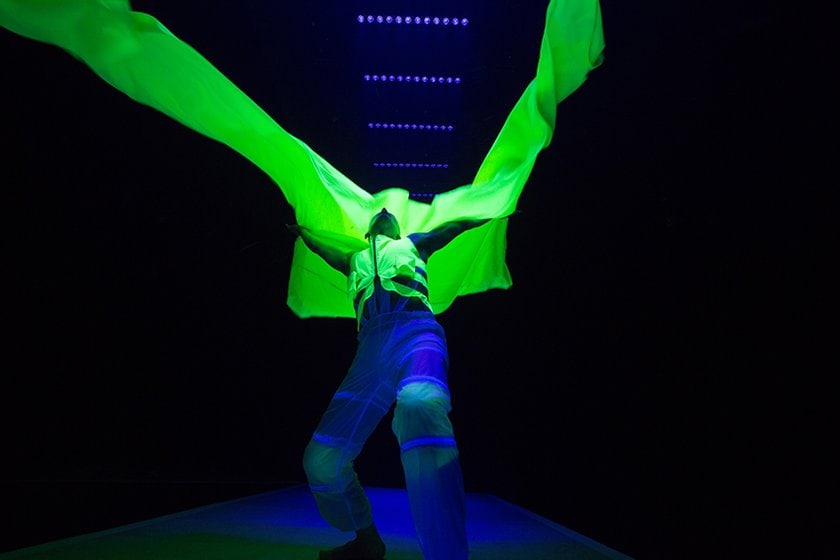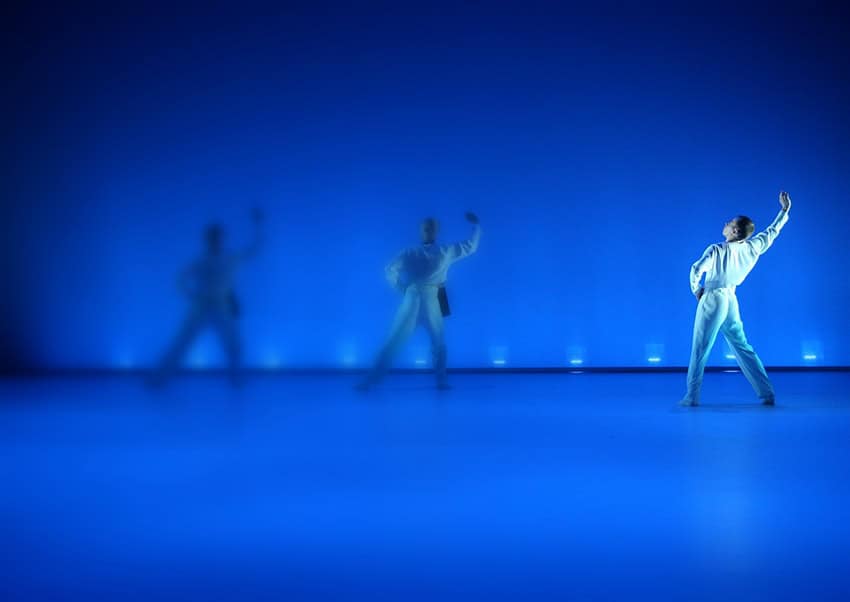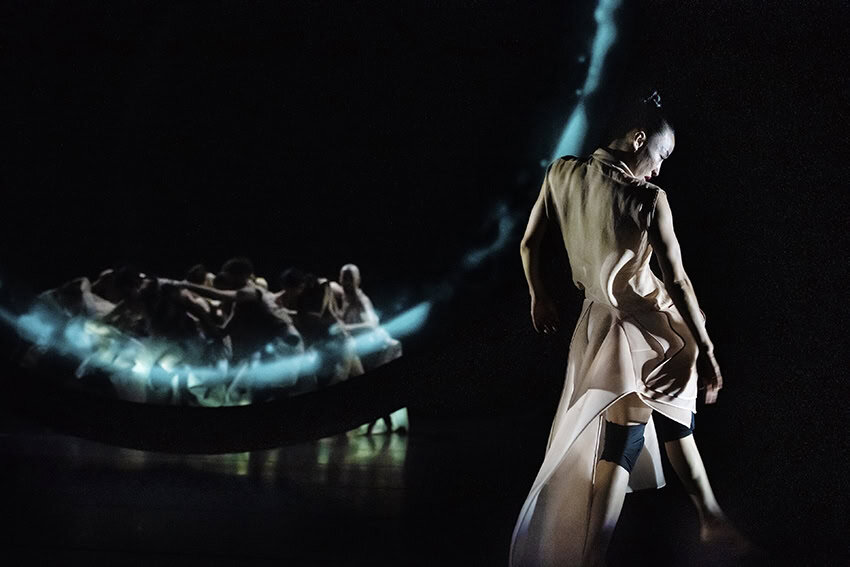Choreographer and Lighting Designer: The association between Tero Saarinen and Mikki Kunttu
Posted: July 30th, 2021 | Author: Nicholas Minns | Filed under: Interview | Tags: Mikki Kunttu, Tero Saarinen, Tero Saarinen Company, TSC | Comments Off on Choreographer and Lighting Designer: The association between Tero Saarinen and Mikki Kunttu
The choreographer, Tero Saarinen, trained as a dancer in the rigorous Vaganova system and joined the Finnish National Ballet. He started to create choreographic solos and duets through spending time by himself in the studio listening to ‘other voices’ in his head and giving them shape. Only when Ohad Naharin saw one of his early works in 1994 and invited him to create on Batsheva Dance Company did the notion of becoming a choreographer begin to materialize. Before that, however, Saarinen had decided to pull up his career as a dancer and to put down choreographic roots, setting out for Japan whose culture and dance traditions had always attracted him. Finding much in common between the mental landscapes of Japan and Finland, in particular the cultivation of a minimal, almost frugal way of living, it is perhaps unsurprising that Saarinen was drawn to the dance form of Butoh. For a year he studied under the guidance of its co-founder, Kazuo Ohno — then in his eighties — and his son, Yoshito, as well as in workshops with Akiko Motofuji, the widow of Butoh’s co-founder, Tatsumi Hijikata. Saarinen seems to have found in Butoh a freedom of expression that derives from turning oneself inside out. Considering Ohno’s performances were, in his son’s words, ‘an occasion on which those ghosts dormant in him come to life’, Saarinen’s search for a choreographic form for his ‘other voices’ had providentially found a kindred spirit. It was as if the edges of Saarinen’s identity both as a Finn and as a classical dancer dissolved in the creative chemistry of Ohno’s workshops. The experience, he recalls, ‘completely changed my understanding of what dance can be and what can be achieved through it…how movement can be used to express the hidden, forgotten or repressed peripheries of humanity.’ He also shared with Ohno his empathy for the natural environment; Ohno once remarked in a workshop, ‘Make your dance more lifelike. You can grasp what life is all about by simply studying how a tree grows.’ For Saarinen the comingling of the spirit of Butoh with his Finnish roots created a choreographic amalgam that continues to transcend cultural barriers, revealing contrasting sensitivities and awakening new understandings. In formulating his aesthetic approach to dance making, Saarinen has remarked that “the dominance of words numbs us from a more sensory-rich experience of reality. By investing more in sensing, we could eventually experience each other, nature and life in a more holistic way.”
The lighting designer, Mikki Kunttu, started out as a guitarist in a rock band and decided to study sound production at the Tampere School of Arts and Communication. Having started the course, however, he discovered it was concentrated solely on television and radio so he decided to change to the study of light, where he felt immediately at home with both his fellow students and his teacher. Kunttu recalls that his course was heavily weighted on the technical aspect; the creative side revealed itself to him only very gradually. “Later on, I understood that if you want to create and understand your own style or even aim to look for it, you’ll have to do this in-depth work on your own…The connection to your own artistic expression is a very personal thing and requires a level of solitude.”
Having developed along similar introspective paths towards discovering their own artistic expression, Kunttu and Saarinen seemed destined to work together. When Saarinen returned from Japan in 1993, he was commissioned by Dance Theatre MD in Tampere to create his first evening of work and was assigned as his lighting designer a student in his first year of study. “My first lighting design project for the school was for contemporary dance”, Kunttu recalls. “Tero happened to be the choreographer. It was the very first time I had come across contemporary dance at all. I think we really hit it off from the get-go.” Saarinen’s recollection was less sanguine: “Mikki reminded me that at the premiere I was so nervous I stayed behind the lighting board with him and kept asking how it was going.” The evening evidently went well enough for the two to continue working together on projects over the next couple of years and when Saarinen created Westward Ho! in 1996 their collaboration was sealed, marking the official beginning of Tero Saarinen Company (TSC).

What these two artists with their contrasting sensitivities had in common was that they were open to dialogue. “We never wanted to stick to something that ‘seemed to work in the past’”, recalls Kunttu. “There’s always been this strong will to create and to explore together. It’s always been very important for me to have a free hand in terms of the design. I believe over the years we have really built a concrete base of confidence between us. The creative process is always very fragile and if this sort of confidence and trust is achieved and cultivated, it is really the best grounds for creative work. It’s not often with other choreographers that lighting would inspire concrete changes of choreography on stage or even help create something completely new. Tero is very aware of the light and the space and that way of working is a big inspiration for me.” He readily acknowledges, however, that “the main obstacle is approaching visuality too much from the technical perspective, thus letting the tech overshadow the creative inspiration…I consider the tech as being the brush you paint with; it’s no use focusing on the brush when you’re painting.” For Saarinen, Kunttu “not only illuminates the action on stage, but also creates architectural and emotional spaces. He is innovative, constantly updating his skills and looking for new ways to implement the art of lighting design, both in the theatre and in other kinds of spaces. All of this is fascinating and inspiring.”
Although TSC has a strong Finnish identity, Saarinen believes in collaboration and cultural exchange programs — in the 25 years of the company’s life, he has worked with artists from Kenya, Australia, China, the Czech Republic, France, Germany, Israel, Italy, Japan, South Korea, Sweden, Norway and the US — as key elements in constructing all the company’s activities on fundamental humanist values — equal rights and respect for all individuals — as well as on education. The basis for this was laid during his stay in Japan where he was able to attend private Nihon buyohclasses led by Yoko Fujima to understand and learn the basics of traditional Japanese dances. “A huge amount of detail and internal information is passed down from generation to generation. The fact that I, a complete outsider, was able to be part of this chain for a while…made me reflect on the importance of active, constructive and respectful intergenerational dialogue and transmission of knowledge…I believe the only way to really learn and make our lives better is through communication and transmission between nations, generations and traditions. All these elements, experiences, and tastes have shaped my choreographic thinking and are reflected in both my creations and teaching.” Saarinen has developed what he calls the Tero Technique, an approach to movement that focuses on awakening all the senses and activating every cell and nerve ending (it has also been called ‘butoh with wings’). “Technically, we pay a lot of attention to the feet, fingers, eyes and skin. The goal, both in the class and during the creative process, is to create an environment where the participant feels safe to take risks and develop. When dancers are 360 degrees aware and 100% present, they become authentic, vibrant and also more diverse. All of this leads to a dance that is constantly morphing and surprising, like flora and fauna.”
This simile of natural regeneration is one that pervades Saarinen’s thinking. He remains passionate about creating and while he feels some of his works can stand the test of time, he doesn’t want his company to become ‘a museum’. “We want to serve as a springboard for those interested in exploring and developing their own choreographic movement language and this art form. Our common dream is to provide opportunities, mentor and promote the next generation of dance makers, sound designers, lighting designers etc. I think the idea of total artwork needs constant updating and it feels great to be helping future generations on this path of development.”
Two years before the Covid-19 pandemic, Kunttu had moved with his two teenage sons to Montreal to work with the Cirque du Soleil, where he was able to continue to push the boundaries of his art. “Lighting designers have always introduced new ways of visual storytelling and I see them as the bold risk-takers always willing to make another leap into the unknown…They have pushed the envelope of stage performance more than any other profession in the field.” But as soon as the effects of the first lockdown took hold and it became clear that Cirque du Soleil would close, Kunttu brought his family back to Finland where he has managed to set up a new studio. He has ongoing projects — he is the production designer for the Finnish National Opera’s upcoming Wagner Ring cycle — but most have had their realizations postponed. Although he is happy to have made the decision to return to Finland, it’s been very difficult to keep afloat in an artistic discipline that has suffered inordinately from the disruption of the pandemic.
For Saarinen, the pandemic coincided with the 25th anniversary of his company but despite the restrictions TSC managed to celebrate the opening of its new office and studio space in Helsinki’s Cable Factory, to maintain its network of staff and to initiate two residencies. However, all its plans for artistic collaborations and exchanges had to be put on hold. With live performances curtailed, one project Saarinen was able to undertake with filmmaker Thomas Freundlich (who made a wonderful documentary on Saarinen in 2018 called Rooted With Wings) is a multi-camera filmed re-enactment of his Third Practice that had premiered for the Monteverdi Festival in 2019. With a return to live performance for the Helsinki Festival, TSC is planning to present the Finnish première of Transit on August 19-21 in the new studio space, a work that had its world première last October at Malmö Opera as a co-production with Skånes Dansteater. In line with one of Saarinen’s all-consuming themes, Transit ‘examines our relationship with nature’ as a ‘frantically performed ritual, a fight for survival and change’ that adds his eloquent choreography to the multiplicity of artistic voices expressing concern about the current environmental crisis.
In the Spring of 2022, the new Tanssin Talo, or Dance House, will open in Helsinki and TSC is a key partner in establishing its path into the future. It will be a culmination of many years of dance advocacy in Finland by Saarinen, his colleagues and supporters, and he is naturally enthusiastic: “The new house will serve as a unifying address and event platform for the presentation of a wide range of dance truths and as a stage for international guest performances. It will also be our home stage so we will perform more in Finland. In addition to our home performances, we will also co-produce guest performances with Tanssin Talo.”

With the backlog of interrupted engagements, and the long arc of production schedules, it will be a few years before Kunttu will be in a position to light a new work by Saarinen —there are, however, several accomplished freelance lighting designers and supervisors, in addition to Kunttu, listed on TSC’s web site (Third Practice has lighting design by Eero Auvinen, and Transit by Minna Tiikkainen). But for the opening season at Tanssin Talo Saarinen plans to stage some of his key works for which Kunttu designed the lighting (including the post-apocalyptic Breath), so there will be a chance to celebrate their long and prolific collaboration. Kunttu, who has always correlated the high energy levels of lighting with the energy of dance, has worked with many choreographers, “but a creation with Tero always feels like coming home.” It’s a neat temporal intersection that Kunttu’s fiftieth birthday should coincide with the twenty-fifth anniversary of TSC as it moves into its new home.